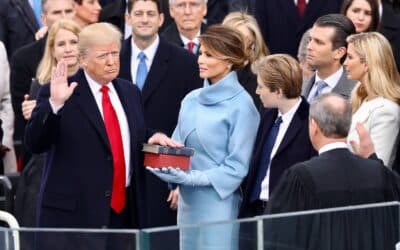Former President Doanld Trump privately met with his top economic advisors last week and discussed plans for major tariff increases, three people familiar with the meeting told the Washington Post. One of the ideas which was floated involves a “universal baseline tariff” on nearly all imports to the US, which may be as high as 10 percent.
In attendance were former senior White House officials Larry Kudlow and Brooke Rollins, former House speaker Newt Gingrich, as well as conservative commentator Stephen Moore. According to the report, Trump’s advisors have been debating for months what the tariff rate should be without reaching a consensus. However, recently on Kudlow’s Fox Business show, Trump called for setting the universal tariff at 10 percent “automatically.”
“I think we should have a ring around the collar” of the US economy, Trump told Kudlow. “When companies come in and they dump their products in the United States, they should pay, automatically, let’s say a 10 percent tax… I do like the 10 percent for everybody.”
Currently, Washington levies an average tariff on imports of roughly three percent. Although, the rate is greater for some countries such as China, whose products face an average duty of 19 percent.
During his administration, Trump imposed tariffs on $200 billion worth of Chinese imports, triggering a trade war. He also put tariffs on a plethora of foreign goods, such as steel, aluminum, washing machines, and solar panels.
His successor Joe Biden has maintained the tariffs on China, despite the damage done to the US economy as a result of these policies. As the Post notes, “most of the trade barriers Trump imposed on China were ultimately extended by the Biden administration, and they have been praised by influential unions for promoting domestic industry. Biden has taken several economic measures that have fueled international trade tensions, including domestic subsidies for clean-energy firms that have been sharply criticized by the European Union.”
Under Biden, the economic war with Beijing has been expanded. In addition to increasing sanctions and decoupling with parts of China, the White House seeks to significantly limit US investments in the country as well as cripple the Chinese semiconductor industry.
This comes amid Washington’s “pivot to Asia,” launched more than a decade ago by former President Barack Obama. The policy was bolstered by Trump and vastly escalated by Biden. The “pivot” is the largest military buildup since the Second World War, shifting two thirds of all US Air and Naval forces to the Asia-Pacific, encircling China for a future war.
Trump’s competitors for the 2024 GOP nomination also favor bellicose economic policies regarding Beijing. Vivek Ramaswamy, for instance, has proposed a “total decoupling” with China, which would make direct conflict more likely. Regarding the island of Taiwan, along with fellow candidate Chris Christie, Ramaswamy has boasted of his willingness to send US troops to fight a direct war with China.
Adam Posen, president of the Peterson Institute for International Economics, told the Post that Trump’s plan would devastate the US economy, especially consumers and workers. Moreover, it would cause the world’s other large economic powers to conclude the US is an untrustworthy trading partner.
“A 10 percent tariff would hurt the thousands of U.S. firms that depend on imports, while also crippling the thousands of U.S. firms that depend on foreign export market,” regardless of Trump’s intent to shore up domestic production, Posen said. Adding, “You’d be depriving American families of an enormous amount of choice, making their lives much more expensive, and putting millions of people out of work.”
Even former Trump officials are raising the alarm. Economist Paul Winfree, who served as Trump’s deputy director of the Domestic Policy Council, warned that – while the Federal Reserve is already struggling to limit inflation – “a tariff of that scope and size would impose a massive tax on the folks who it intends to help.”
Gingrich defended the plan, arguing when the US was “the dominant economy, free trade was the rational strategy. Whether that’s still a rational strategy is unclear.”
































